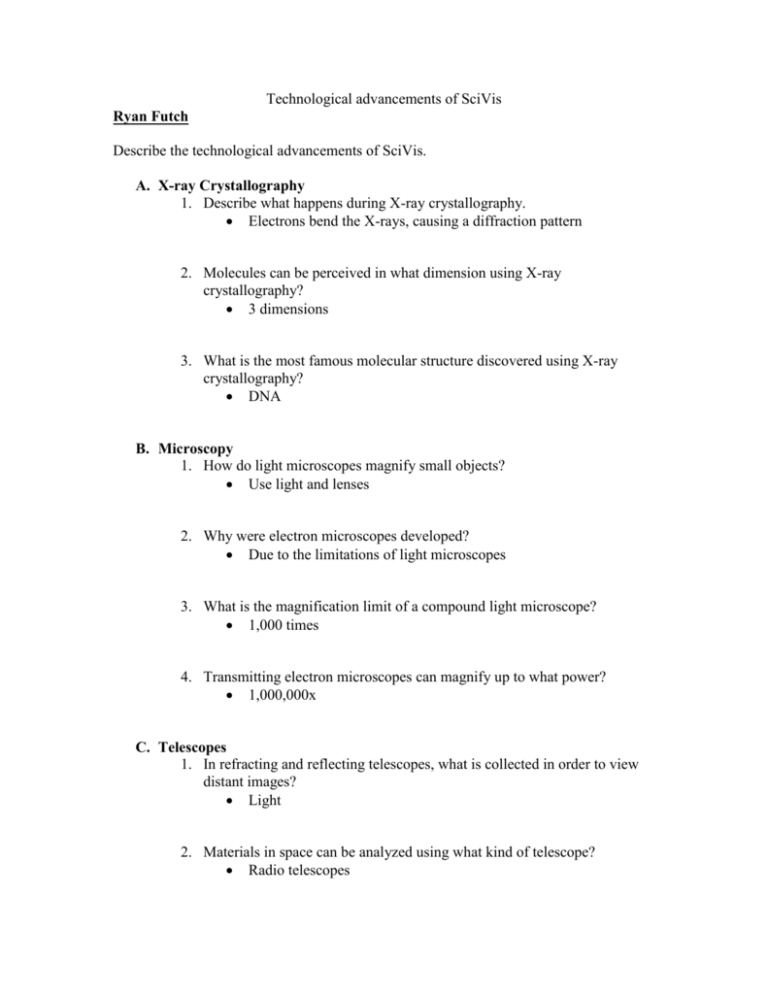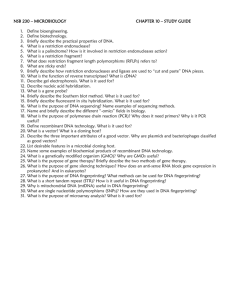Tech Advances in SciVis worksheet. ryan futch..doc
advertisement

Technological advancements of SciVis Ryan Futch Describe the technological advancements of SciVis. A. X-ray Crystallography 1. Describe what happens during X-ray crystallography. Electrons bend the X-rays, causing a diffraction pattern 2. Molecules can be perceived in what dimension using X-ray crystallography? 3 dimensions 3. What is the most famous molecular structure discovered using X-ray crystallography? DNA B. Microscopy 1. How do light microscopes magnify small objects? Use light and lenses 2. Why were electron microscopes developed? Due to the limitations of light microscopes 3. What is the magnification limit of a compound light microscope? 1,000 times 4. Transmitting electron microscopes can magnify up to what power? 1,000,000x C. Telescopes 1. In refracting and reflecting telescopes, what is collected in order to view distant images? Light 2. Materials in space can be analyzed using what kind of telescope? Radio telescopes 3. Radio telescopes collect what to understand space? Radio waves 4. What problem is eliminated by using an orbiting telescope such as the Hubble telescope? Looking through the atmosphere D. DNA Fingerprinting 1. What is the genetic material found in the nucleus of cells? DNA 2. DNA is unique to each individual with one exception. What is the exception? Identical twins 3. Briefly describe the process of DNA fingerprinting. Comparing fragments of DNA 4. What are the steps of DNA fingerprinting? First, obtaining a DNA sample from body tissue or fluid Then cut into pieces using enzymes Segments are arranged by size using gel electrophoresis 5. How has DNA fingerprinting helped the advancement of paternity testing? If they take two samples of DNA and if the samples match, the two samples probably came from the same person 6. How has DNA fingerprinting helped the advancement of forensic science? Map out the entire Human genome helped figure out a lot of uses for DNA 7. The mapping of the entire human genome was known as what project? Human Genome Project 8. In what year was the mapping of the entire human genetic code accomplished? 2003 E. Computers 1. Describe one way computers have helped to manipulate large amounts of data? Allowed us to go on the internet, save data to hard drives, etc. 2. Describe one way computers have helped to automate machinery, tools, and processes? Allows us to use all this in one place without us having to lift a finger (besides when typing) 3. Describe how the Internet allows for the rapid and widespread movement of data. Can surf the internet and go from page to page without have to get out of the chair F. Medical Imaging 1. What are the short wavelengths that penetrate tissue and used to produce negative images of bones? X-rays 2. What does MRI stand for? Magnetic Resonance Imaging 3. Describe how an MRI works. Uses magnets in medical settings to produce computer enhanced images of the soft tissue inside the human body 4. Describe a MRI, CAT, and PET scan. A large X-ray machine used to get an image of the entire body, brain, or skull G. Remote Sensing 1. What does GPS stand for? Global Positioning System 2. Briefly describe how GPS works. Able to show an exact position on the earth anytime, anywhere outside, and in any weather 3. List and describe 3 different types of satellites. Astronomy Communications Navigation 4. Define what is meant by remote sensing. Sensing, by satellites, tracking or recording images or objects by satellite 5. What does RADAR stand for? RAdio Detection And Ranging 6. Briefly describe how radar and sonar work. Use electromagnetic waves to determine location, position, and movement of objects H. Virtual Reality 1. Briefly describe what is meant by Virtual Reality. Computer generated three-dimensional images that allow the user to interact with a virtual world 2. Describe 3 uses for Virtual Realty. Computer gaming Flight simulators Industrial design 3. Explain how a hologram is produced. Multiple lasers, light scattered from an object to be recorded and projected onto another object






